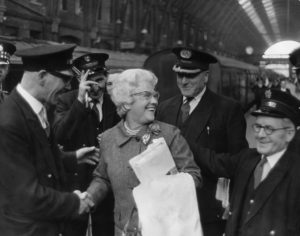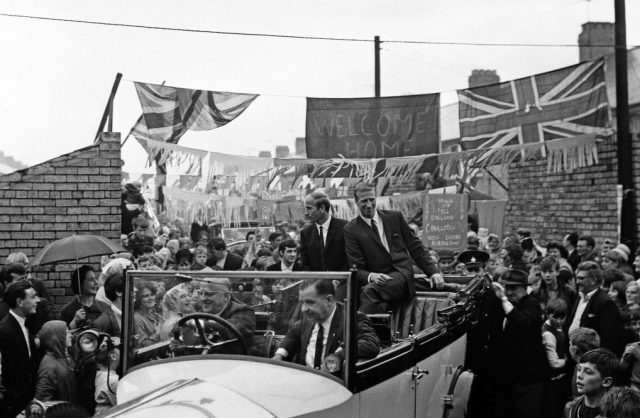Bobby and Jack Charlton in Ashington after their World Cup win. Credit: Staff/Mirrorpix via Getty Images

In late July 1966, a nervous nation sat glued to their TV screens as England took on Portugal in the World Cup semi-final. But Bob Charlton — the father of the two brothers who were the lynchpins of that England team — was 360ft underground, cutting coal at Linton Colliery in Ashington. He was only told the score when he came to the surface. That vignette came to mind with the passing this month of Jack Charlton, who was always proud of his roots in the Northumberland coalfield. His life represented so much that was distinctive in Northumbrian culture — from his love of working men’s clubs to his passion for the countryside of his native county — that his death felt like a genuine watershed as that old world slips further from our grasp.
For the most perfect summation of how his Northumbrian upbringing shaped the man who became one of the greatest footballers, and football managers, of his generation, turn to the 1971 Tyne Tees TV documentary Big Jack’s Other World. It is a joyful, time-travelling 25 minutes, as Jack returns to Ashington for a weekend of whippet racing, brass bands and pints in the club. For me, it was almost exquisitely painful to watch: having grown up in Northumberland in the 1980s, I saw the glowing embers of the pit village life he describes so fondly, as well as characters who look and speak and laugh like the kind, hard-working folk I knew in places like New Hartley and Seaton Delaval.
For Northumbrians, “h’yem” (home), has a more profound meaning than just the place where one lives. It means belonging to a homeland, a heimat; it evokes the spirit of the Welsh hiraeth, or the Portuguese saudade — that sense of longing for a missing time and place.
What’s so striking about this film about Jack’s homecoming is the magnetic personality of the man himself. He’s a natural in front of camera, displaying an easy charm as he meets his old neighbours, and respectfully asks if he can have a look inside 114 Beatrice Street, the colliery row where he grew up and shared a bed with his three brothers until he left home to join Leeds United. Not only is Ashington the only English town to have three native World Cup winners — Jack and Bobby Charlton, plus the England cricketer Mark Wood — but Beatrice Street alone produced three Footballers of the Year: the Burnley and England star Jimmy Adamson grew up there, too.

When Andy Haldane, Chief Economist at the Bank of England, visited Ashington in 2018 he was struck by just how badly depleted the town had been by 40 years of decline. In a speech, he remarked that what he saw of the town’s local economy had shocked him, even as he was impressed by the warmth of its people. In his words, here was “barren economic tundra, permanently leeched of nutrients“.
But in Big Jack’s Other World, we see Ashington at perhaps its most confident and prosperous: the pits were still major employers, Station Road was the biggest shopping area between Newcastle and Edinburgh (with one of the grandest Co-op stores in the North of England), and the working men’s clubs — of which there were dozens in the district — were genuinely luxurious, and vied with each other to have the fanciest concert rooms to attract the biggest stars.
In the film we see Jack in his element, getting a round in at the Northern Social Club in North Seaton — “there you are lads, get stuck into these” he says, setting down a tray of pints in front of his confreres — before launching into an arcane debate with his father about what type of wild geese they saw that morning. Indeed, with his fascination for birdlife and love of angling on the Tweed (or, in later life, on the Moy in County Mayo), Jack was a great naturalist in the Northumbrian tradition of Lancelot Brown, Thomas Bewick and the fly-fishing Foreign Secretary, Sir Edward Grey.
The only jarring note amid all this cheerful bonhomie comes with Jack’s views on “women’s lib”. Even in an era where male chauvinism was hardly uncommon, the North East of England stood out as unusually patriarchal. Where it was typical for men and women to work alongside each other in the mills of Lancashire and Yorkshire, the coalfields of Northumberland and Durham were different. Here it was a mark of pride for a miner that his wife did not take on paid work outside the home — where she was needed to service the “aristocrats of labour”, as the pitmen saw themselves, much as a groom would look after a horse.
So as the Charlton menfolk stagger back home after their midday session, they’re greeted by an irritated Cissie Charlton standing at the stove in her housecoat. Ensuring that the men of the house were fed first was a custom that my own grandmother — a pitman’s wife — observed well into the 2000s. As they sit down to their dinner, Jack holds forth on the duties of women, and how girls should be brought up: “strictly.” How the women felt about this was not discussed. This is what purely economic analyses of the decline of mining towns like Ashington tend to miss: the fact that these coalfield communities relied as much on a reserve army of (largely unpaid) female labour — and all the constraints and narrowed horizons that came with that — as much as they did on government backing for nationalised industries.

Yet Jack himself had taken one look at the coalface as a teenager and decided the pitman’s life wasn’t for him. And though he was always loyal to Ashington — and even campaigned alongside Arthur Scargill in the 1980s — he was clear-eyed about the limitations of the world he grew up in. As Danny Finkelstein noted in a perceptive piece about how forward-thinking and entrepreneurial Charlton always was — in football coaching and in his business interests — when Jack looked back on the defeat of the miners’ strike, he remarked: “If you were to talk to some of them now, they would tell you that the closing of the mines was the best thing that ever happened to them. They have found a new lifestyle, and, more importantly, new hope.” But for many of them, “new hope” meant leaving Ashington behind.
Tyne Tees TV itself was once an important vehicle for regional pride. The 1970s was its golden age of documentary making, with serious attention given to caricatural North East pursuits, with wonderful films on leek-growing and pigeon racing — both manifestations of that typical Northumbrian love of the natural world. But then, as Antony Brown wrote in his 1978 book Tyne Tees Television: The First 20 years, A Portrait, the station’s purpose was to paint a portrait of:
“a land of wide skies, bent vowels, saints, footballers, shipyards and an inventive tradition which has produced the finest engineers in England: its landscape swings from wild moorland to industrial cities and back again to the sea-fretted coast of Northumberland, Durham and North Yorkshire.”
Jack Charlton was great on the grandeur of that Northumbrian landscape. In a later travelogue for Tyne Tees, The Coast of King Jack, he swaggers along the Northumberland littoral from Amble to Bamburgh like a bandy-legged gun slinger, tossing out historical tidbits and bantering amusingly with the locals. Since Jack’s death, I have read so many testimonies from ordinary people about his personal warmth, kindness, and approachability. These qualities were nurtured in the tight-knit streets of Ashington, the “biggest pit village in the world”, and Northumbrian sociability is still one of the region’s strongest selling points.
Jack took charge of Ireland’s national team in 1986, a fraught time for Anglo-Irish relations. It was his personal charisma, and love of a pint — as much as his prowess as a football manager — that undoubtedly endeared him so much to the Irish people. After sending them into raptures at Italia 90 and USA 94, no man since the thirteenth century came closer to being anointed High King of Ireland than Big Jack (although honorary Irish citizenship and the Freedom of Dublin were high enough honours).
As this touching David Squires cartoon in the Guardian illustrated so well, here was a man who was genuinely loved. Other than perhaps the great Terry Wogan, no one did more to affect a rapprochement between England and Ireland — after decades, even centuries of mistrust. Bill Corcoran of the Tyneside Irish Centre said it well when he tweeted:
“A mighty Northumberland footballing statesman. His influence, in bringing friendship and peace between people, in his beloved England and Ireland in terrible times was pivotal but under-appreciated.”
Or, as the Irish international Johnny Giles once put it, Bobby and Jack Charlton were “great ambassadors for both football and for working-class England”. What’s made Jack’s death so poignant is that part of that old working-class England has died with him.
Dan Jackson is the author of the best-selling book The Northumbrians: The North East of England and its People. A New History, published by Hurst (2019)










Join the discussion
Join like minded readers that support our journalism by becoming a paid subscriber
To join the discussion in the comments, become a paid subscriber.
Join like minded readers that support our journalism, read unlimited articles and enjoy other subscriber-only benefits.
Subscribe